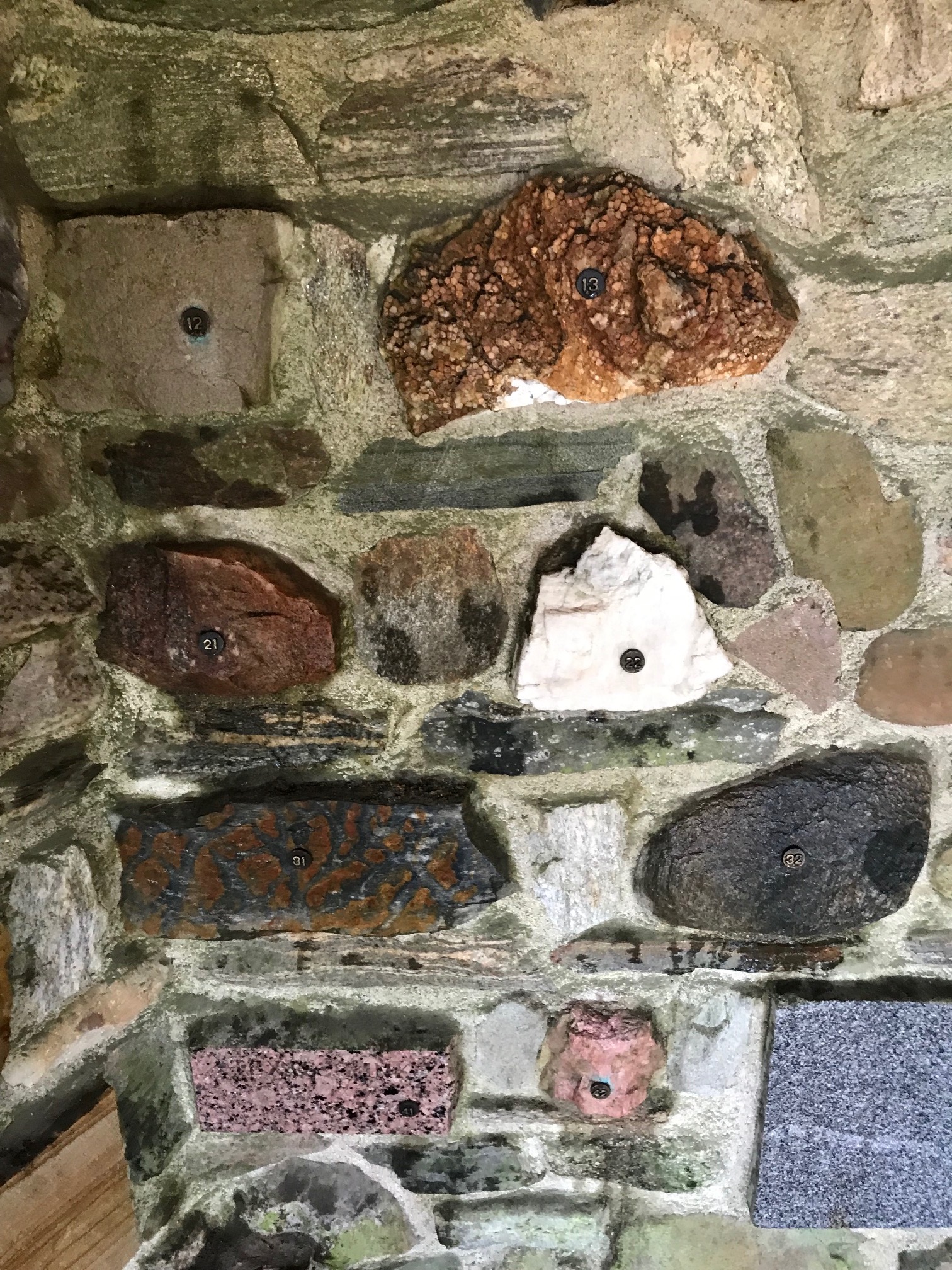The Stone Pavilion Project
The Stone Specimen Collection

The main collection of 50 specimen stones contains a great variety of kinds of rock types, shapes, sizes, and objects collected. Thus page links to two separate classificationsn, one by rock type, and another by the stone as an object, i.e. whether a cut slab or a fieldstone boulder.
Classifications of Stone by Rock Type
Link to Classification by Rock Type (Lithology).
-
Sedimentary: With 21 stones out of a total of 50, this is the largest category of the specimen stones. Of these: 12 are composed of what we call "terrigenous" meaning sourced from the land to produce particles. We use this term to contrast it with the many limestones, which were precipitated in the sea. 10 of these terrigenous rocks are sandstones, 8 consisting mostly of quartz sand, and called arenites), 2 sandstones contain less weathered particles, making them arkose rather than arenite. 7 are marine limestones, consisting principally of lime mud, sand, and shell fragments. 3 are dominantly mud and are all rich in whole fossils. 2 are grainstones, which are sandstones composed of particles of limestone (calcite), often shell fragments. 1 sample, from Iowa, is effectively a chunk of an ancient reef. 1 sample from Louisiana, is crystalline, perhaps lime mud that has recrystallized. 1 specimen is a fossil tree from Petrified Forest, AZ. In this case, the stone is the fossil. 1 specimen is a mixture of sand derived from the land with abundant shelly fragments.
-
Igneous: With 16 stones out of 50, this is the second largest category. There are 12 plutonic rocks, all of which are granitic, 7 of which are true granites, and 5 are related rocks. There are 4 volcanic rocks, all of which are extrusive basalts, 3 of which are vesicular, and 1 an olivine porphyry.
-
Hydrothermal: This third largest category has 6 specimens form in fractures and veins. 4 are quartz veins, 3 of which are milky quartz and 1 rose quartz. Without more detailed analysis, these cannot be classified as either igneous or metamorphic because we don't have the host rock in which they formed. The remaining 2 are considered pegmatites, a special kind of igneous rocks that form from late-stage brines during final cooling. Ours are characterized not by unusually large crystals but by intergrowths of feldspar and quartz in what's called a perthitic texture. Our two specimens, from South Dakota and Mississippi are unusually similar to one another in composition, size, and shape.
-
Metamorphic: We have 5 metamorphic stones. Of these, 3 are unfoliated, with 2 being quartzites that formed from quartz-rich sandstones, and 1 being a serpentenite formed during the subduction (and obduction) of oceanic crust. Our 2 foliated rocks are both granitic gneisses, rocks that were subjected to so much heat and pressure that they nearly melted.
-
Complex: The final category includes 2 rocks that don't fit into the trinity of igneous, sedimentary, and metamorphic. 1 is a highly geochemically altered, originally igneous rock from Montana so altered and infused with metals that it was mined as silver ore. 1 is a breccia from Connecticut that started out as a an arkose sandstone, but was broken into fragments within fault zone and the pore spaces were filled by minerals precipitated from geothermal fluids.
Classification by Object
Link to Classification by Object.
-
Broken Blocks and Slabs: 26 of our specimen stones, slightly more than half, are jagged-edged blocks and slabs of broken rock. There are no rounded corners. These are fragments that likely just picked up.
-
Cut Dimension Stone: 13 of our specimens are rectangular shaped slabs and blocks. 10 were cut into shape with a saw, with perfect corners. 3 were split to shapes. The cut faces range from polished to irregular. These were likely obtained from quarries.
-
Natural Boulders: 8 specimens are boulders, 4 of which were preserved whole, and 4 were split or broken before mounting, leaving at least one rounded edge.
-
Natural Cobbles: Two cobbles were preserved, 1 whole and 1 broken.
-
Whole Fossils: Our specimen is a slab cut from a fossilized tree trunk from Arizona. The original host rock, presumably a shale or mudstone, is gone, leaving only the fossil itself.
Collecting PreferencesS
Based on the frequencies above, we can interpret the collecting preferences of the collector, Albert P. Marsh. He visited many quarries, preferring cut dimension stone if he could find it, collecting 13 of these across all categories. He has a preference for milky colored vein rock, collecting 5 specimens, 3 of quartz and 2 perthite (?). On three occasions, he sampled the rough top of a lava flow. He collected 12 specimens or granite or related rocks , 10 sandstones obtained from land sources, and 3 limestones visibly rich in visible fossils. Two of his specimens are whole fossils, the tree-trunk from Arizona and the extinct coral reef from Iowa.